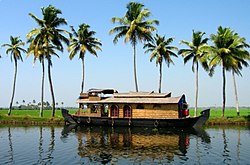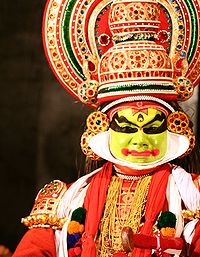KERALA
Kerala regionally referred to as Keralam, is a state in the south-west region of India on the Malabar coast. It was formed on 1 November 1956 as per the States Reorganisation Act by combining various Malayalam-speaking regions. Spread over 38,863 km2 (15,005 sq mi) it is bordered by Karnataka to the north and north east, Tamil Nadu to the east and south, and the Laccadive Sea to the west. With 33,387,677 inhabitants as per the 2011 census, Kerala is the twelfth largest state by population and is divided into 14 districts. Malayalam is the most widely spoken and official language of the state. The state capital is Thiruvananthapuram.
The region was a prominent spice exporter from 3000 BCE to 3rd century. The Chera Dynasty was the first powerful kingdom based in Kerala, though it frequently struggled against attacks from the neighbouring Cholas and Pandyas. During the Chera period Kerala remained an international spice trading center. Later, in the 15th century, the lucrative spice trade attracted Portuguese traders to Kerala, and eventually paved the way for the European colonisation of the whole of India. After independence, Travancore and Cochin joined the Republic of India andTravancore-Cochin was given the status of a state. Later, the state was formed in 1956 by merging the Malabar district, Travancore-Cochin (excluding four southern taluks), and the taluk of Kasargod, South Kanara.
Kerala is the state with the lowest positive population growth rate in India (3.44%) and has a density of 819 people per km2. The state has the highest Human Development Index (HDI) (0.790) in the country according to the Human Development Report 2011.[3] It also has the highestliteracy rate (93.91%), the highest life expectancy (74 years) and the highest sex ratio (as defined by number of women per 1000 men: 1,083 women per 1000 men) among all Indian states. Kerala has the lowest homicide rate among Indian states, for 2011 it was 1.1 per 100,000.[5] A survey in 2005 by Transparency International ranked it as the least corrupt state in the country. Kerala has witnessed significant emigration of its people, especially to the Persian Gulf countries during the Kerala Gulf boom during the 1970s and early 1980s, and its economy depends significantly on remittances from a large Malayali expatriate community. Hinduism is practised by more than half of the population, followed byIslam and Christianity. Malayalam is the major spoken language. Although it is considered the "cleanest state in India", the morbidity rate, at 118, is the highest in the country[citation needed]. The culture of the state traces its roots from 3rd century CE. It is a synthesis of Aryan and Dravidiancultures, developed over centuries under influences from other parts of India and abroad.

Production of pepper and natural rubber contribute a prominent portion of the total national output. In the agricultural sector, coconut, tea, coffee, cashew and spices are important. The state has 590 km of coastal belt, and around 1.1 million people of the state are dependent on the fishery industry which contributes 3% of the state's income. The state's 145,704 kilometres (90,536 mi) of roads, constitute 4.2% of all Indian roadways. There are three existing and two proposed international airports. Waterways are also used as a means of transportation. The state has the highest media exposure in India with newspapers publishing in nine different languages; mainly English and Malayalam. Kerala is an important tourist destination, with the backwaters, beaches, Ayurvedic tourism, and tropical greenery among its major attractions.

Culture[edit]
Main article: Culture of Kerala
The culture of Kerala is composite and cosmopolitan in nature and it's an integral part of Indian culture.[21] It has been elaborated through centuries of contact with neighboring and overseas cultures.[303] However, the geographical insularity of Kerala from the rest of the country has resulted in development of a distinctive lifestyle, art, architecture, language, literature and social institutions.[21] There are around 10,000 festivals celebrated in the state.[304] TheMalayalam calendar, a solar calendar started from 825 CE in Kerala,[305] finds common usage in planning agricultural and religious activities.[306]
Dance[edit]
Main article: Arts of Kerala
Kerala is home to a number of performance arts. These include five classical dance forms: Kathakali, Mohiniyattam, Koodiyattom, Thullal andKrishnanattam, originated and developed in the temple theatres during the classical period under the patronage of royal houses.[307] Kerala natanam,Kaliyattam, Theyyam, Koothu and Padayani are other dance forms associated with the temple culture of the region.[308] Some traditional dance forms such as Margamkali, Parichamuttu and Chavittu nadakom are popular among the Christians,[309][310][311] while Oppana and Duffmuttu are popular among the Muslims of the state.[309][312]
Music[edit]
Development of classical music in Kerala is attributed to the contributions it received from the traditional performance arts associated with the temple culture of Kerala.[313] Development of the indigenous classical music form, Sopana Sangeetham, illustrates the rich contribution that temple culture has made to the arts of Kerala.[313] Carnatic music dominates Keralite traditional music. This was the result of Swathi Thirunal Rama Varma's popularisation of the genre in the 19th century.[303] Raga-based renditions known as sopanam accompany kathakali performances.[314] Melam; including the paandi andpanchari variants, is a more percussive style of music:[315] it is performed at Kshetram-centered festivals using the chenda.[316] Panchavadyam is a different form of percussion ensemble, in which artists use five types of percussion instrument.[317] Kerala's visual arts range from traditional murals to the works of Raja Ravi Varma, the state's most renowned painter.[313] Most of the castes and communities in Kerala have rich collections of folk songs and ballads associated with a variety of themes; Vadakkan Pattukal (Northern Ballads), Thekkan pattukal (Southern Ballads), Vanchi pattukal (Boat Songs),Mappila Pattukal (Muslim songs) and Pallipattukal (Church songs) are a few of them.[318]
Cinema[edit]
Main article: Cinema of Kerala
Malayalam films carved a niche for themselves in the Indian film industry with the presentation of social themes.[319][320] Directors from Kerala, like Adoor Gopalakrishnan, John Abraham, Kamal and G. Aravindan, have made a considerable contribution to the Indian parallel cinema. Kerala has also given birth to numerous actors, such as Satyan, Bharath Gopi, Prem Nazir, Mammotty, Mohanlal, Suresh Gopi, Dileep, Murali, Oduvil Unnikrishnan, Cochin Haneefa,Thilakan and Nedumudi Venu. Late Malayalam actor Prem Nazir holds the world record for having acted as the protagonist of over 720 movies.[321] Since 1980s, actors Mammootty and Mohanlal have dominated the movie industry; Mammootty has won three national awards while Mohanlal has two to his credit.[322]
Literature[edit]
Malayalam literature starts from the late medieval period and includes such notable writers as the 14th-century Niranam poets (Madhava Panikkar, Sankara Panikkar and Rama Panikkar),[323][324] and the 17th-century poet Thunchaththu Ezhuthachan, whose works mark the dawn of both modern Malayalam language and poetry.[325][326] Paremmakkal Thoma Kathanar and Kerala Varma Valiakoi Thampuran are noted for their contribution to Malayalam prose.[327][328][329] The "triumvirate of poets" (Kavithrayam): Kumaran Asan, Vallathol Narayana Menon, and Ulloor S. Parameswara Iyer, are recognised for moving Keralite poetry away from archaic sophistry and metaphysics, and towards a more lyrical mode.[330][331][332]
In the second half of the 20th century, Jnanpith winning poets and writers like G. Sankara Kurup, S. K. Pottekkatt, Thakazhi Sivasankara Pillai, M. T. Vasudevan Nair and O. N. V. Kurup had made valuable contributions to the modern Malayalam literature.[333][334][335][336][337] Later, writers like O. V. Vijayan, Kamaladas, M. Mukundan, Arundhati Roy, had gained international recognition.[338][339][340][341]
Cuisine[edit]
Main article: Cuisine of Kerala
Kerala cuisine has a multitude of both vegetarian and non-vegetarian dishes prepared using fish, poultry and meat. Culinary spices have been cultivated in Kerala for millennia and they are characteristic of its cuisine.[342] Rice is a dominant staple that is eaten at all times of day.[343] Breakfast dishes are frequently based on the rice preparations idli, puttu Idiyappam, or pulse-based vada or tapioca.[344] These may be accompanied by chutney, kadala,payasam, payar pappadam, Appam, egg masala and fish curry.[194] Lunch dishes include rice and curry along with rasam, pulisherry and sambar.[345]Sadhya is a vegetarian meal, often served on a banana leaf and followed with a cup of payasam.[346] Popular snacks include banana chips, yam crisps, tapioca chips, unniyappam and kuzhalappam.[347][348][349] Non-vegetarian dishes, including those with beef and pork, are popular in the state.[350] Sea food specialities include karimeen, prawn, shrimp and other crustacean dishes.[351] One of the popular non-vegetarian cuisine in North Kerala is the Malabar biriyani, Kozhikode biriyani and Thalassery biriyani are its variations. The specialty is that it uses Khyma Rice, (a fragrant, short or small size, Bangladeshi rice) and "do not" use basmati like other biriyani recipe





